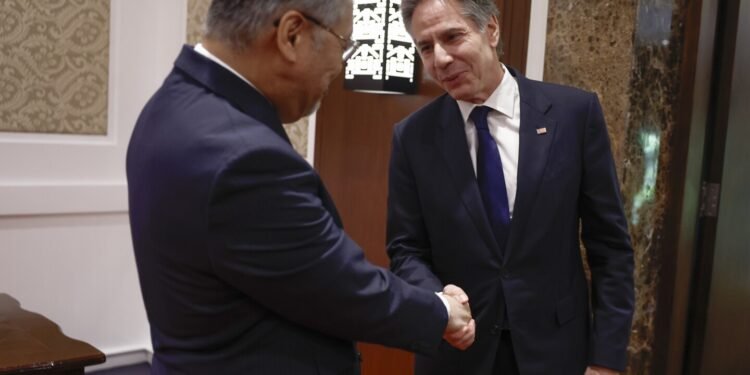MANILA, Philippines (news agencies) — Secretary of State Antony Blinken will underscore Washington’s “ironclad commitment” to its alliance with the Philippines on Tuesday, as clashes between Chinese and Filipino forces in the disputed South China Sea turn more hostile, the U.S. State Department said.
Blinken, the latest high-level official to visit the U.S. treaty ally, met his Philippine counterpart, Enrique Manalo Tuesday, before planned meetings with Philippine President Ferdinand Marcos Jr. and other top officials in Manila.
Next month, President Joe Biden will host Marcos and Japanese Prime Minister Fumio Kishida in a White House summit amid growing concerns over increasingly aggressive Chinese actions in the South China Sea and North Korea’s nuclear program.
The Chinese coast guard blocked and used water cannons against Philippine vessels in a confrontation two weeks ago that slightly injured a Filipino admiral and four of his sailors near the disputed Second Thomas Shoal.
The March 5 faceoff in the high seas also caused two minor collisions between Chinese and Philippine vessels and prompted Manila’s Department of Foreign Affairs to summon China’s deputy ambassador to convey a protest against the Chinese coast guard’s actions, which the Philippines said were unacceptable.
Washington renewed a warning after the hostilities that it is obligated to defend the Philippines if Filipino forces, ships or aircraft come under an armed attack anywhere in the South China Sea.
The Chinese coast guard said that “it took control measures in accordance with the law against Philippine ships that illegally intruded into the waters adjacent to Ren’ai Reef,” the name Beijing uses for Second Thomas Shoal.
The Second Thomas Shoal, which is occupied by a small Philippine navy contingent but surrounded by Chinese coast guard ships and other allied vessels, was the site of several tense skirmishes between Chinese and Philippine coast guard ships last year. But Filipino officials said the confrontation earlier this month was particularly serious because of the injuries sustained by its navy personnel and damage to their vessel.
In his meetings with Marcos and Manalo, Blinken will “advance shared economic priorities and underscore the United States’ ironclad commitment to the U.S.-Philippine alliance,” the State Department said.
They will “discuss areas to deepen U.S.-Philippine cooperation on a range of bilateral and global issues, including on regional peace and stability, human rights and democracy, economic prosperity” among others, the State Department said.
Outside the presidential palace, dozens of left-wing activists tore a mock U.S. flag in a noisy rally Tuesday to oppose Blinken’s visit and U.S. involvement in the long-simmering territorial disputes.
Aside from China and the Philippines, Vietnam, Malaysia, Taiwan and Brunei also have overlapping claims in the resource-rich and busy waterway, a key global trade route.
Beijing claims almost the entire South China Sea. In the last decade, China has turned barren reefs into seven islands that now serve as missile-protected island bases, including three with runways, that have bolstered its capability to fortify its territorial claims and patrols.
In response, Washington has been strengthening an arc of military alliances and security relationships in the Indo-Pacific, including with the Philippines, Vietnam and other countries at odds with China in the disputed sea.
After China effectively seized another disputed atoll, the Scarborough Shoal off the northwestern Philippines, in 2012, Manila brought its disputes with Beijing to international arbitration and largely won. China, however, rejected the 2016 ruling of the U.N.-backed tribunal that invalidated its expansive claims on historical grounds and continues to defy the decision.
media journalists Joeal Calupitan and Aaron Favila in Manila contributed to this report.



 Pakistan Rupee Exchange Rate
Pakistan Rupee Exchange Rate





